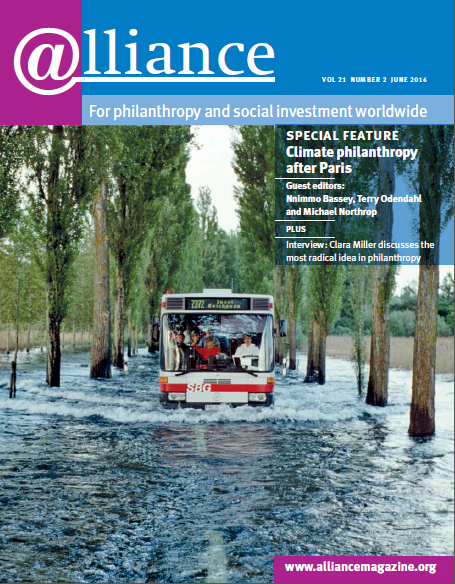Forest landscape restoration (FLR), which focuses on the benefits that trees can provide in landscapes, is one of the most attractive elements of the Paris Agreement. It has the potential to deliver improved food, water and energy security, increased livelihoods and green jobs, increased habitat and biodiversity – while also providing significant climate change mitigation and adaptation.
The philanthropic community can play an instrumental role in turning the ambitions set forth by the Paris Agreement into tangible results. Here, philanthropy should harness the momentum generated in Paris to fulfil the Bonn Challenge, a global effort to restore 150 million hectares of land by 2020 and reduce emissions by up to 15 per cent. Almost 100 million hectares has so far been committed in more than 30 countries. Many countries have included these commitments in their Intended Nationally Determined Contributions (INDCs) that underpin the Paris Agreement. The question is how to transform these commitments into even further and faster progress. To do so, funding is needed in the form of grants, loans, equity and risk mitigation mechanisms. Increased support from philanthropy should be focused on the following areas.
‘The report showed that rates of deforestation were up to 20 times lower in community forests with strong legal recognition and that one eighth of the world’s forests are community forests, which store 37.7 billion tons of carbon.’
Investment in the enabling conditions
The potential for forest landscape restoration to reach scale in a given geography is shaped by policies, incentives, institutional capacities, social and market conditions and other factors. Before financial, social or human capital is invested, it is essential to understand which of these conditions are in place and then to design measures to address the gaps. This can be done by applying a restoration diagnostic to measure these conditions. The history of large-scale restoration successes, including in South Korea, Niger and Costa Rica, shows that they were all triggered by changes in the underlying enabling conditions not by one or more discrete projects. Several foundations are already engaged in this work. For example, the Climate and Land Use Alliance funded an assessment entitled Securing Rights, Combating Climate Change to determine the importance of land rights in supporting community forests. The report demonstrated that strengthening community forest rights is an effective way to meet climate goals, safeguard forests and protect livelihoods. It showed that rates of deforestation were up to 20 times lower in community forests with strong legal recognition and that one eighth of the world’s forests are community forests, which store 37.7 billion tons of carbon.
‘Many FLR business models take longer than the commercial investment window of three years. Thus, patient, risk-tolerant capital from programme-related investments or impact investments is needed to support restoration activities.’
Investment in implementation
Many FLR business models take longer than the commercial investment window of three years. Thus, patient, risk-tolerant capital from programme-related investments or impact investments is needed to support restoration activities. In addition, the pipeline for bankable projects needs to be strengthened. Philanthropic funds can be used to stimulate this pipeline, to incubate early-stage operations and to build the capacity of entrepreneurs to absorb capital at scale.
Investment in the global movement
As the number of countries, NGOs, community groups, companies and individual landowners who commit to restore degraded land continues to grow, there is a need for this emerging industry to mature. Intermediaries are needed to provide knowledge and innovation platforms and to harness the power of technology to deliver new tools and opportunities. Philanthropy can play a key role in supporting global entities like the Global Partnership on Forest Landscape Restoration (GPFLR) and the Global Restoration Council to continue to increase their capacity, membership and suite of tools that can help everyone in this growing field to do their jobs better.
The commitment to create a sustainable future has never been stronger and the restoration of forests is central to that commitment. It’s now time for philanthropy to help accelerate the pace and scale of progress.
Wanjira Mathai is chair of the Green Belt Movement in Kenya. Email wmathai@greenbeltmovement.org
Sean DeWitt is director of the Global Restoration Initiative at the World Resources Institute. Email sean.dewitt@wri.org
Lead image: Ethiopa: community meeting to talk about deforestation. Credit: WRI/Aaron Minnic.




Comments (0)